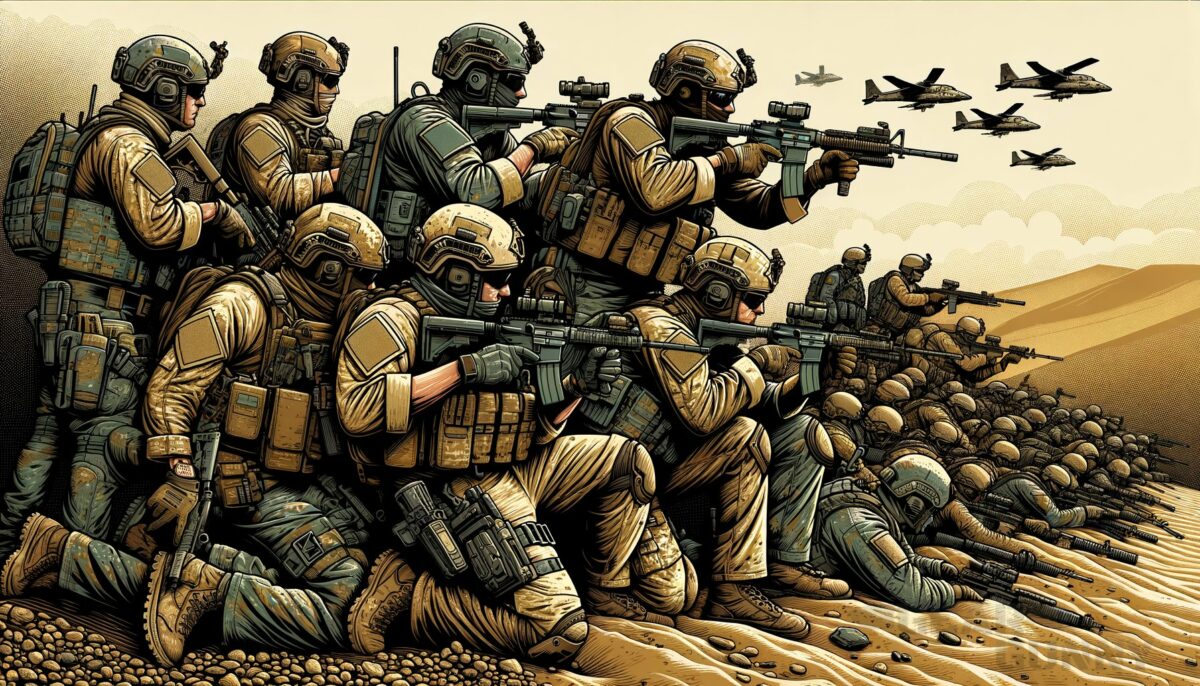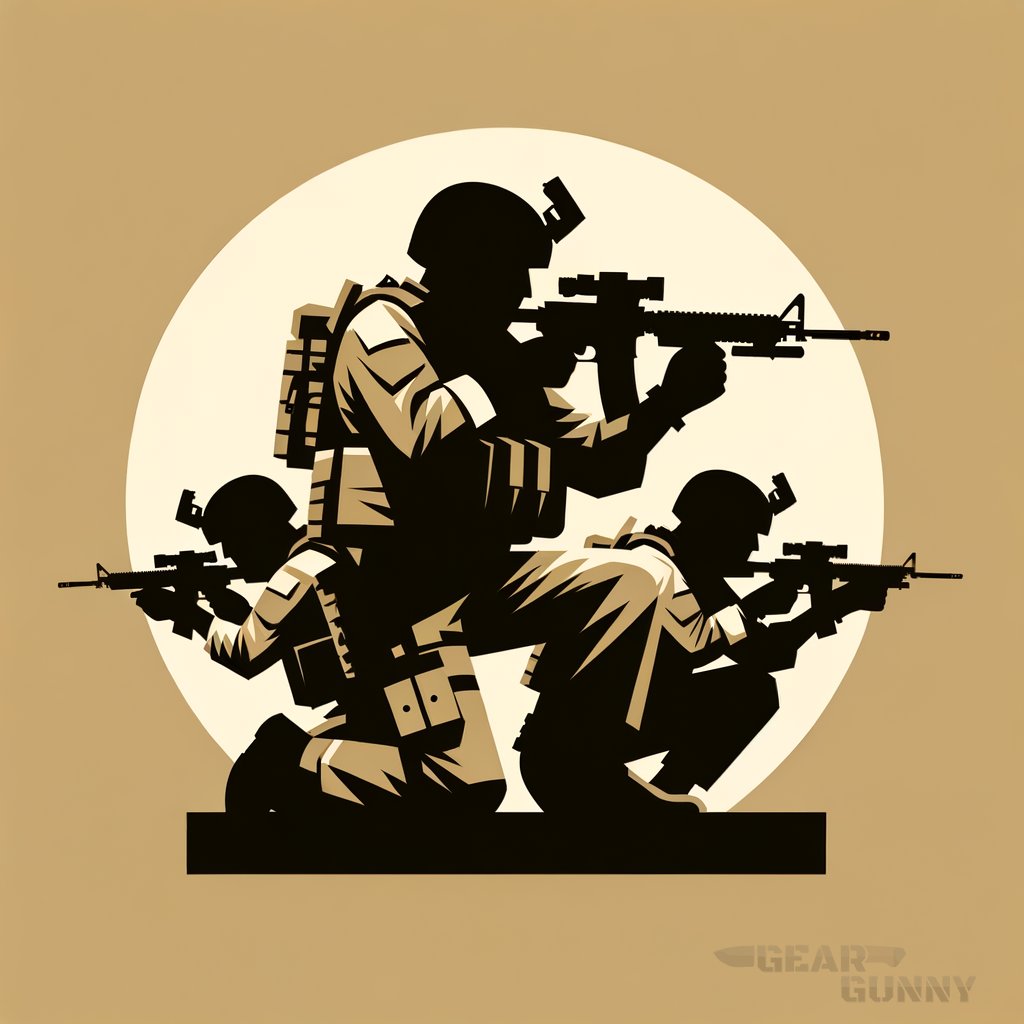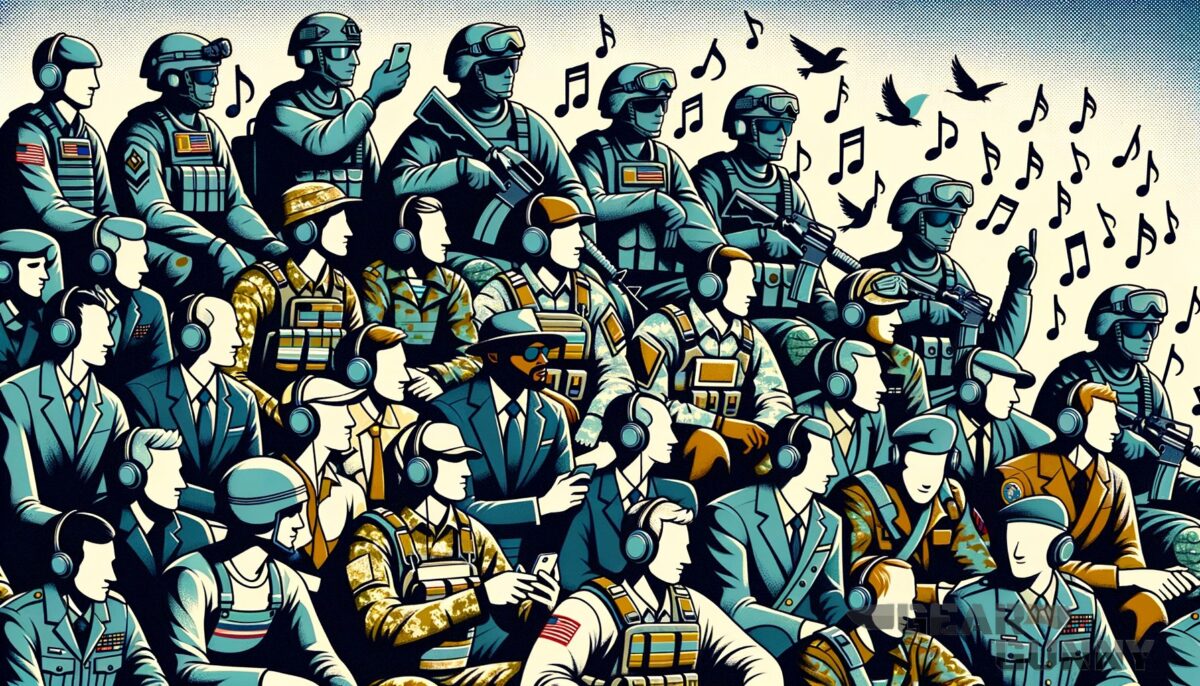Ever found yourself in the middle of an unexpected situation, like a sudden car breakdown? Just like being prepared with a solid plate carrier in a skirmish, understanding ambush tactics could mean life or death in military terms. In this post, we’ll dive into the tactical world of ambushes, exploring what they entail and their significance on the battlefield.
Key takeaways
- An ambush is a <b>surprise attack</b> from a concealed position on a moving or temporarily halted target, designed to catch the enemy off-guard.
- There are two types of ambushes: <b>hasty and deliberate</b>; both aim for a decisive victory but vary in planning and execution.
- Ambush tactics require <b>meticulous planning</b> and understanding of roles within the team, making them as much about intelligence as about firepower.
What is an ‘Ambush’ in military terms?
An ambush, in the military sense, is akin to a well-orchestrated surprise attack. Imagine you’re walking down a familiar path, one you’ve trekked dozens of times before, and out of nowhere, chaos erupts. That’s what an ambush is all about—catching the enemy where they feel safe, but where you’ve lain in wait, camouflaged and quiet as the grave.

To grasp the idea behind an ambush, it’s worth dissecting its fundamental aspects: * Execution: This is the crux of an ambush—laying low and hitting hard when the adversary least expects it. * Planned vs. Opportunistic: Ambushes are of two sorts.
Hasty ambushes occur when troops stumble upon an enemy and rapidly react. Deliberate ambushes are premeditated, with detailed strategy and a chosen location. * Formations and Techniques: Effective execution hinges on using formations like linear or L-shaped, each tailored for different scenarios.
A successful ambush can turn the tide of a skirmish, inflicting significant damage with minimal exposure.
With a proper grasp of ambush dynamics, devils and dogs alike can strategically outmaneuver foes. Whether you’re a well-versed tactician or a burgeoning grunt, understanding these tactics is crucial.
I’m no tactician or combat leader, but I’ll tell you what I think about military ambushes. A strategic move like an ambush is what separates the rookies from the seasoned veterans. It’s all about good intel, patience, and a surprise factor that knocks the wind out of your enemy.
To me, it’s proof that sometimes brains trump brute force.
Yet, there’s this raw and genuine part of me that gets uneasy about the whole “hiding and hitting” thing. Real-life ain’t like an airsoft match where you can get up after taking a hit. In real combat, ambushes are downright deadly, both for the ambushers and those on the receiving end.
But I suppose that’s the harsh truth of warfare, something our military personnel train for, knowing full well the stakes involved.
5.11 Rush 24 Tactical Backpack

5.11 Rush 24 Tactical Backpack
Understanding the ambush
An ambush is a military tactic that dates back to the dawnstones of warfare. Here we break down the essential components of an ambush, providing insights into its mechanism and historical significance.
What defines an ambush?
An ambush is a strategic surprise attack by camouflaged forces on an unsuspecting enemy. Typically, the attackers lie in wait, concealed, aiming to strike when the enemy is most vulnerable—during movement or at a halt. * Predetermined: Attackers have chosen their moment, usually based on intelligence.


“Timing is critical; you want to hit the enemy when they’re most stretched out and vulnerable. Proper execution requires precise planning and coordination, which can be hard to achieve under stress but can lead to a decisive victory.”
* Surprise and Concealment: Key elements of any ambush, maximizing the shock factor and reducing exposure to return fire. * Enemy Engagement: The goal is decisive victory, usually achieved by trapping the enemy in a kill zone.
The concept may sound straightforward, but a successful ambush requires skill and coordination, relying on the ability to predict enemy movements and exploit terrain.
Hasty versus deliberate ambushes
Ambushes come in two main types: hasty and deliberate. Understanding their differences is crucial for grasping their tactical applications. * Hasty ambush: It unfolds quickly as an unplanned opportunity arises.
Troops need to be swift and adaptable to set an effective ambush when the chance presents itself. * Deliberate ambush: This involves intricate planning and setup, usually aiming to engage the enemy in a particular area where conditions are most favorable for the attackers.
Both types require solid training and a profound understanding of ambush tactics, which are instilled in soldiers from basic training and honed over their military careers.
Planning and execution of an ambush
Careful planning is the backbone of a deliberate ambush. Let’s walk through the setup leading to the moment of truth.
Location
Choosing a prime ambush site is a tactical art form. Commanders search for locations that grant cover and a clear field of fire into the kill zone while also making a flank assault by the enemy difficult.
Kill zone
This is where the enemy will be isolated or destroyed, requiring natural obstacles to trap them and enough space for observers to direct the engagement.
Security
The role of security is to shield the assault and support teams as they establish their positions. The security forces ensure the element of surprise remains intact until the ambush is triggered.
By understanding each element’s role and positioning, troops hone the orchestration of a deadly and effective ambush.
Defense against an ambush
Avoiding an ambush is preferable over countering one, and situational awareness is a soldier’s best defense. Measures include varying travel routes, using reconnaissance for route selection, and traveling in large, cautious formations.
Unfortunately, if troops find themselves in an ambush, the immediate response is to “step on the gas,” returning fire to buy precious seconds needed for escape.
Historical and modern relevance
From the ancestors hunting big game to contemporary battlefields, ambushes have consistently proved their devastating efficiency. Armies continue to teach and evolve ambush techniques, acknowledging their effective use throughout history in altering the outcomes of conflicts.
In the matrix of military tactics, the ambush remains a timeless and critical maneuver. This data table highlights the key components of an ambush, distilled from the given information, offering a condensed view of what constitutes a powerful military ploy.
| Component | Description | Examples |
|---|---|---|
| Execution | Surprise attack from concealment | Attacking a patrolling enemy |
| Types | Hasty and deliberate with varying degrees of planning | Quick response vs. premeditated setup |
| Training | Skills ingrained from basic training, refined in ensuing courses | Basics taught in Boot Camp, honed in Ranger School |
| Formations | Linear and L-shaped, designed to control the kill zone | Linear in open areas, L-shaped in bends |
| Location | Selection critical for attack efficacy, including fields of fire and escape routes | Chosen based on terrain analysis |
| Kill Zone | Area where concentrated fire isolates or destroys the enemy | Size and obstacles are key factors |
| Security | Protects assault teams, ensures surprise, and provides more support | Positioned to avoid interference with assault elements |
| Rally Points | Pre-established safe locations for regrouping if dispersed | Must be defensible and have good cover |
| Defense | Strategies to avoid or counter an ambush | Increased vigilance and quick, decisive action upon contact |
More ambush tips
Ambushes are a blend of art and science, requiring a thorough understanding and precise execution. Here are extra nuggets of wisdom to consider when planning or defending against an ambush.
- Timing is critical; you want to hit the enemy when they’re most stretched out and vulnerable.
- Communication is key; make sure every participant knows the plan and can recognize both visual and audio signals.
- Rehearse your ambush; even a hasty ambush benefits from troops that are well-drilled and know their roles instinctively.
- Natural elements can be allies; use weather, light conditions, and landscape to your advantage.
- Keep your exit as clean as your entry; have a sharp extraction plan that everyone understands.
When it comes to the do’s and don’ts of ambushes, there’s a fine line between success and failure. Here’s a table that summarizes some critical best practices:
| Do’s | Don’ts |
|---|---|
| Do: Rehearse the ambush multiple times | Don’t: Become predictable by using the same ambush tactics |
| Do: Choose a location with optimal fields of fire and escape routes | Don’t: Neglect the importance of quick and silent communication |
| Do: Use the element of surprise to your advantage | Don’t: Underestimate the enemy’s ability to fight back or call for support |
| Do: Ensure all participants understand their role | Don’t: Let down your guard before ensuring the enemy is neutralized |
Advantages and disadvantages of ambush
Ambushes, like every other military tactic, have their upsides and downsides. It’s key to weigh these before deciding to engage using an ambush tactic.
Advantages
- Surprises the enemy, leading to potentially massive and rapid casualties.
- Allows a smaller force to take on a larger one by neutralizing the enemy’s numerical advantage.
- It uses the terrain and element of surprise to reduce the risk to the ambushing force.
- Can significantly damage enemy morale and disrupt their operations.
Disadvantages
- If the ambush is detected early, the ambushing force could be caught in a vulnerable position.
- Proper execution requires precise planning and coordination, which can be hard to achieve under stress.
- Relies heavily on accurate intelligence; without it, the chance of failure is high.
- Could lead to unintended escalation or provoke a larger conflict if not well-managed.
If you are a visual learner, check out this video titled ‘Milsim Loadout – Beginner’
Frequently asked questions (FAQ)
How is an ambush different from a regular attack?
An ambush is distinct from a regular attack primarily due to the element of surprise and the attackers being concealed before the strike. Regular attacks are generally more straightforward and can include face-to-face confrontation where both sides are aware of the other’s presence and intentions.
What is the psychological affect of an ambush on soldiers?
The psychological affect on soldiers can be profound as the suddenness and ferocity of an ambush can cause disorientation, fear, and confusion. It’s also a powerful tool to instill fear and reduce morale among enemy troops, showcasing vulnerability in seemingly safe areas or routines.
Can technology help prevent ambushes?
Yes, technology such as drones, motion sensors, and advanced reconnaissance methods can significantly aid in detecting potential ambush sites and movement patterns of adversaries, thereby helping to anticipate and prevent ambush attacks before they can be executed.
Final thoughts
In the world of military strategy, the ambush stands out as a testament to the importance of surprise, preparation, and the strategic advantage of terrain. It reminds us that in war, as in life, the unexpected can wield tremendous influence over the outcome of events. As we close this chapter on ambush tactics, remember the cunning, courage, and adaptability these operations require from our armed forces.
Ever wonder how you’d fare under the pressure of a sudden ambush? Did I cover everything you wanted to know? Let me know in the comments section below.
I read and reply to every comment. If you found this article helpful, share it with a friend, and don’t forget to check out my full blog for more tips and tricks on tactical military techniques. Thanks for reading, and stay sharp out there, devil dogs!















